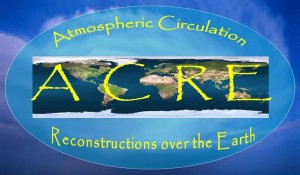
The International Atmospheric Circulation Reconstructions over the Earth (ACRE) initiative both undertakes and facilitates the recovery of historical instrumental surface terrestrial and marine global weather observations to underpin 3D weather reconstructions (reanalyses) spanning the last 200-250 years for climate applications and impacts needs worldwide. All of the historical surface weather data and the reanalyses are freely available.
The international Atmospheric Circulation Reconstructions over the Earth (ACRE) initiative both undertakes and facilitates the recovery of historical instrumental surface terrestrial and marine global weather observations to underpin 3D weather reconstructions (reanalyses) spanning the last 200-250 years for climate applications and impacts needs worldwide. All of the historical surface weather data and the reanalyses are freely available.
ACRE achieves this outcome by:
- linking international meteorological organizations & data rescue infrastructures to facilitate the recovery, extension, quality control & consolidation of global historical terrestrial & marine instrumental surface data covering the last 250 years;
- making these observations available to all international reanalyses;
- ensuring that 3D reanalysis products can be tailored/downscaled to seamlessly flow into various climate applications & production models.
Core Partners
ACRE is led by a consortium of seven core partners – the Queensland State Government and the University of Southern Queensland in Australia; the Met Office Hadley Centre (MOHC) in the UK; the US National Oceanic and Atmospheric Administration (NOAA) Earth System Research Laboratory (ESRL) and Cooperative Institute for Research in Environmental Sciences (CIRES) at the University of Colorado; The National Climatic Data Center (NCDC) of NOAA and the University of Giessen in Germany plus the University of Bern in Switzerland.
To learn more about ACRE, view the November issue of the Bulletin of the American Meteorological Society (BAMS) at:

Comments are closed.